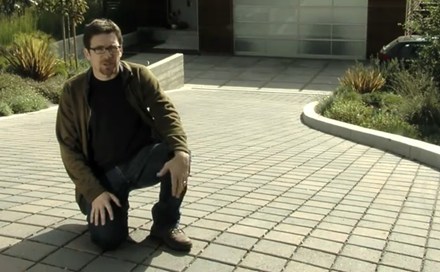Permeable Paver Driveway
Learn how to tie in permeable pavers with other types of paving on this property's driveway.
A video transcript featuring Joseph Huettl, Huettl Landscape Architecture
On this project, the homeowners wanted to incorporate as many green building techniques as they could into the project, and there are some site concerns about site runoff to the neighbors. So combining those two concerns, and with a driveway of this size, the thing that made sense to do was a permeable driveway. And there are different techniques for doing permeable driveways, but in this case, the most aesthetic and nicest solution seemed to be to do interlocking pavers that are designed for permeability. These are very popular right now. They seem to be the next big thing in interlocking paving. They're designed with gaps with infill with the granular base rock, and that allows the water to soak between the pavers into the base rock below.
Paving materials
When you do this kind of permeable paving, the base rock underneath is different than the standard base rock. It has to be a permeable gravel without the fine material, and to put in your soil types, you have to do a pretty deep profile. In this case, there's a full 10 inches of base rock underneath a 3-inch paver. So you have more than a 12-inch profile of excavation that has to be done for such a thing.
This driveway is a combination. We have the lower parking areas as cast-in-place concrete squares, with gravel between that to allow permeability. But for the slope, that wasn't such a good solution because of the potential for movement. So on the sloped area, we had to follow the contours of the curve to bring it up to grade. Since the street slopes down, this is the best layout for that. And then with this paver type, a lot of these pavers have a certain pattern, and we just didn't want to introduce any new flavors into the design here. So we're happy to find a square paver in a neutral tone that wouldn't compete with the house.






